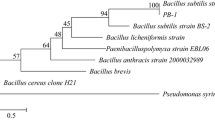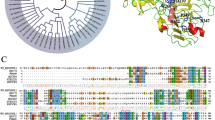Abstract
Pectate lyases catalyze the eliminative cleavage of de-esterified pectin, which is a major component of the primary cell walls of many higher plants. The gene encoding Aspergillus nidulans pectate lyase A (PelA) without signal peptide was fused with a six-His tag at its C-terminus in the expression vector VBSzqx containing Sac b signal peptide and p43 promotor. The VBSzqx-pelA plasmid was transformed into Bacillus subtilis, an expression host that is safe, free of any endotoxin, has a potential for large-scale production of foreign proteins in food industry. PelA was successfully expressed, and effectively purified using a Ni2+-nitrilotriacetate-agarose column. Shaken in flasks, the medium produced the maximum enzyme production of 620 U ml−1 medium at 30°C, 200 rpm, and starting pH 7.0. Higher enzyme production (985 U ml−1 medium) was reached in 2.5-l fermentor at 30°C, pH 7.0, 500 rpm, and 2.0 l min−1 airflow rate. The expressed PelA exhibited its optimal activity at pH 8.5 and 50°C. The V max and K m of recombinant PelA were 77 μmol min−1 mg−1 and 0.50 mg ml−1.





Similar content being viewed by others
References
Baneyx F (1999) Recombinant protein expression in Escherichia coli. Curr Opin Biotechnol 10:411–421. doi:10.1016/S0958-1669(99)00003-8
Benen JA, Kester HC, Parenicova L, Visser J (2000) Characterization of Aspergillus niger pectate lyase A. Biochemistry 39:15563–15569. doi:10.1021/bi000693w
Bradford MM (1976) A rapid and sensitive method for the quantitation of microgram quantities of protein utilizing the principle of protein-dye binding. Anal Biochem 72:248–254. doi:10.1016/0003-2697(76)90527-3
Brockmeier U, Caspers M, Freudl R, Jockwer A, Noll T, Eggert T (2006a) Systematic screening of all signal peptides from Bacillus subtilis: a powerful strategy in optimizing heterologous protein secretion in Gram-positive bacteria. J Mol Biol 362:393–402. doi:10.1016/j.jmb.2006.07.034
Brockmeier U, Wendorff M, Eggert T (2006b) Versatile expression and secretion vectors for Bacillus subtilis. Curr Microbiol 52:143–148. doi:10.1007/s00284-005-0231-7
Carpita NC, Gibeaut DM (1993) Structural models of primary cell walls in flowering plants: consistency of molecular structure with the physical properties of the walls during growth. Plant J 3:1–30. doi:10.1046/j.1365-313X.1993.00999.x
Collmer A, Ried JL, Mount MS (1988) Assay methods for pectic enzymes. Methods Enzymol 161:329–335. doi:10.1016/0076-6879(88)61037-8
de Vries RP, Visser J (2001) Aspergillus enzymes involved in degradation of plant cell wall polysaccharides. Microbiol Mol Biol Rev 65:497–522. doi:10.1128/MMBR.65.4.497-522.2001
Dean RA, Timberlake WE (1989a) Regulation of the Aspergillus nidulans pectate lyase gene (pelA). Plant Cell 1:275–284
Dean RA, Timberlake WE (1989b) Production of cell wall-degrading enzymes by Aspergillus nidulans: a model system for fungal pathogenesis of plants. Plant Cell 1:265–273
Dinu D, Nechifor MT, Stoian G, Costache M, Dinischiotu A (2007) Enzymes with new biochemical properties in the pectinolytic complex produced by Aspergillus niger MIUG 16. J Biotechnol 131:128–137. doi:10.1016/j.jbiotec.2007.06.005
Gonzalez-Candelas L, Cortell A, Ramon D (1995) Construction of a recombinant wine yeast strain expressing a fungal pectate lyase gene. FEMS Microbiol Lett 126:263–269. doi:10.1111/j.1574-6968.1995.tb07428.x
Gummadi SN, Kumar DS (2008) Batch and fed batch production of pectin lyase and pectate lyase by novel strain Debaryomyces nepalensis in bioreactor. Bioresour Technol 99:874–881. doi:10.1016/j.biortech.2007.01.022
Guo W, Gonzalez-Candelas L, Kolattukudy PE (1995) Cloning of a novel constitutively expressed pectate lyase gene pelB from Fusarium solani f. sp. pisi (Nectria haematococca, mating type VI) and characterization of the gene product expressed in Pichia pastoris. J Bacteriol 177:7070–7077
Jayani RS, Saxena S, Gupta R (2005) Microbial pectinolytic enzymes: a review. Process Biochem 40:2931–2944. doi:10.1016/j.procbio.2005.03.026
Kashyap DR, Vohra PK, Chopra S, Tewari R (2001) Applications of pectinases in the commercial sector: a review. Bioresour Technol 77:215–227. doi:10.1016/S0960-8524(00)00118-8
Macmillan JD, Vaughn RH (1964) Purification and properties of a polygalacturonic acid-trans-eliminase produced by Clostridium multifermentans. Biochemistry 3:564–572. doi:10.1021/bi00892a016
Mamma D, Kourtoglou E, Christakopoulos P (2008) Fungal multienzyme production on industrial by-products of the citrus-processing industry. Bioresour Technol 99:2373–2383. doi:10.1016/j.biortech.2007.05.018
Mayans O, Scott M, Connerton I, Gravesen T, Benen J, Visser J, Pickersgill R, Jenkins J (1997) Two crystal structures of pectin lyase A from Aspergillus reveal a pH driven conformational change and striking divergence in the substrate-binding clefts of pectin and pectate lyases. Structure 5:677–689. doi:10.1016/S0969-2126(97)00222-0
Millor GL (1960) Dinitrosalicylic acid reagent for determination of reducing sugar. Anal Chem 31:426–428. doi:10.1021/ac60147a030
Pilnik W, Rombouts FM (1985) Polysaccharides and food processing. Carbohydr Res 142:93–105. doi:10.1016/S0008-6215(00)90736-5
Semenova MV, Grishutin SG, Gusakov AV, Okunev ON, Sinitsyn AP (2003) Isolation and properties of pectinases from the fungus Aspergillus japonicus. Biochemistry (Mosc) 68:559–569. doi:10.1023/A:1023959727067
Soriano M, Diaz P, Pastor FI (2006) Pectate lyase C from Bacillus subtilis: a novel endo-cleaving enzyme with activity on highly methylated pectin. Microbiology 152:617–625. doi:10.1099/mic.0.28562-0
van Rensburg P, Strauss ML, Lambrechts MG, Cordero Otero RR, Pretorius IS (2007) The heterologous expression of polysaccharidase-encoding genes with oenological relevance in Saccharomyces cerevisiae. J Appl Microbiol 103:2248–2257. doi:10.1111/j.1365-2672.2007.03474.x
van Wely KH, Swaving J, Freudl R, Driessen AJ (2001) Translocation of proteins across the cell envelope of Gram-positive bacteria. FEMS Microbiol Rev 25:437–454
Wang PZ, Doi RH (1984) Overlapping promoters transcribed by Bacillus subtilis sigma 55 and sigma 37 RNA polymerase holoenzymes during growth and stationary phases. J Biol Chem 259:8619–8625
Wong SL, Ye R, Nathoo S (1994) Engineering and production of streptokinase in a Bacillus subtilis expression-secretion system. Appl Environ Microbiol 60:517–523
Zhai C, Cao J, Wang Y (2003) Cloning and expression of a pectate lyase gene from B. alcalophillus NTT33. Enzyme Microb Technol 33:173–178. doi:10.1016/S0141-0229(03)00091-7
Zhao QX, Yuan S, Zhang YL, Zhu H, Dai CC, Yang F, Han FM (2007) Expression, purification and characterization of pectate lyase A from Aspergillus nidulans in Escherichia coli. World J Microbiol Biotechnol 23:1057–1064. doi:10.1007/s11274-006-9331-1
Acknowledgments
This work was supported by the funds from the Postdoctorate Science Foundation of China (20070420200), the Postdoctorate Science Foundation of China in Jiangsu Province (0702008B), and the University Nature Science Foundation of China by Jiangsu Education Committee (07KJD180237).
Author information
Authors and Affiliations
Corresponding author
Additional information
This manuscript describes “High-Level Expression and Secretion of Pectate Lyase”. In this study, PelA was successfully expressed from A. nidulans in B. subtilis, and effectively purified using a Ni2+-nitrilotriacetate-agarose column. Enzyme production of the recombinant PelA reached as high as 985 U ml−1 medium, which was more than that of the expressed PelA in E. coli.
Rights and permissions
About this article
Cite this article
Zhao, Q., Ding, R., Kang, Y. et al. Expression of pectate lyase A from Aspergillus nidulans in Bacillus subtilis . World J Microbiol Biotechnol 24, 2607–2612 (2008). https://doi.org/10.1007/s11274-008-9784-5
Received:
Accepted:
Published:
Issue Date:
DOI: https://doi.org/10.1007/s11274-008-9784-5




